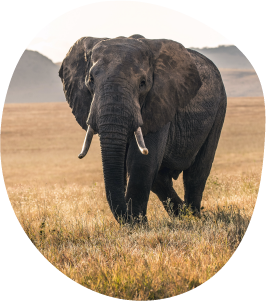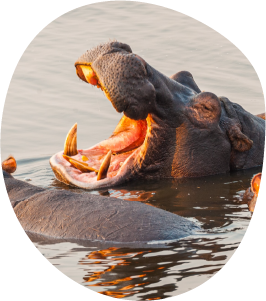WILD LARGE MAMMALS
Rhinos, elephants, and hippos are some of the most iconic animals on earth. These majestic creatures have roamed the planet for millions of years, and their sheer size and power make them an awe–inspiring sight.
The three of them are emblematic animals fascinating, but they also face a variety of threats from poaching, habitat destruction, and climate change. With the right choice of tour, it is possible to admire these animals ethically in their natural habitat with a positive conservation impact.
TOP LARGE MAMMALS-SEEING ETHICAL EXPERIENCES

TRY TO SPOT RHINOS
Unfortunately, rhinos in Africa are on the brink of extinction due to poaching and illegal wildlife trade. Conservation efforts have been put in place to try and protect African rhinos from further decline.

WATCH ELEPHANT HERDS
Elephants are a keystone species in Africa, playing a crucial role in the health and balance of African ecosystems.

OBSERVE HIPPOS
Hippos are native to Africa and are one of the continent's most iconic species. They are most commonly found in the rivers, lakes and swamps of Sub-Saharan Africa.

SUPPORT AN ASIAN ELEPHANT SANCTUARY
Many sanctuaries offer educational opportunities for visitors to learn more about conservation efforts and the welfare of the majestic Asian Elephant. Precaution is advised in order to avoid unethical activities, such as elephant riding.
Where to see wild large mammals?
ALL LARGE MAMMALS BLOG ARTICLES & ETHICAL TOURS RECOMMENDATIONS
ELEPHANTS
Elephants are the largest land mammals in the world and are well known for their intelligence and social behaviour. They live in family groups across Africa and Asia and can live for up to seventy years. Elephants live in matriarchal societies and have been known to demonstrate empathy and compassion towards other animals.
SCIENTIFIC NAME
Loxodonta africana (African bush), Loxodonta cyclotis (African forest), Elephas maximus (Asian)
IUCN STATUS
Critically Endangered (for the African forest elephant) to Endangered (for the two other species)
RANGE
Africa, Asia
HIPPOS
Hippos are large, semi–aquatic mammals native to sub–Saharan Africa. They are the third–largest land mammal in the world, after elephants and rhinos. In the wild, they spend most of their days in water or mud, emerging in the evening to graze on grass and other vegetation. They are also surprisingly agile on land, capable of running at speeds of up to 30km per hour.
SCIENTIFIC NAME
Hippopotamus amphibius
IUCN STATUS
Vulnerable
RANGE
Africa
RHINOS
Rhinos are herbivores, and they primarily eat leaves, twigs, and grasses. They live in dry, grassy plains and wetlands, where they can find enough food to sustain themselves. There are five species of rhinoceros, each with its own unique characteristics. The White Rhino is the most abundant species, and the Black Rhino is the most endangered.
SCIENTIFIC NAME
Rhinoceros
IUCN STATUS
Critically Endangered (Black, Sumatran, Javan rhinoceroses), Vulnerable (Indian rhinoceros), Nearly Threatened (White rhinoceros)
RANGE
Africa, Asia



